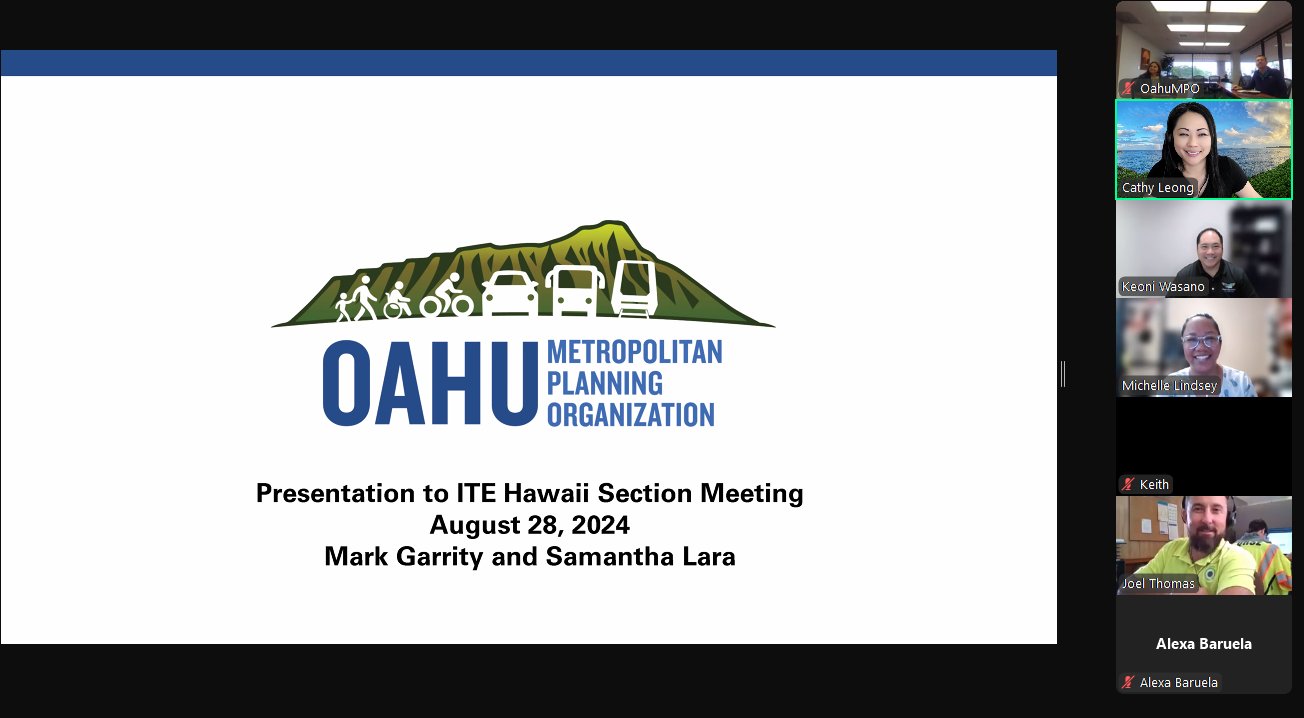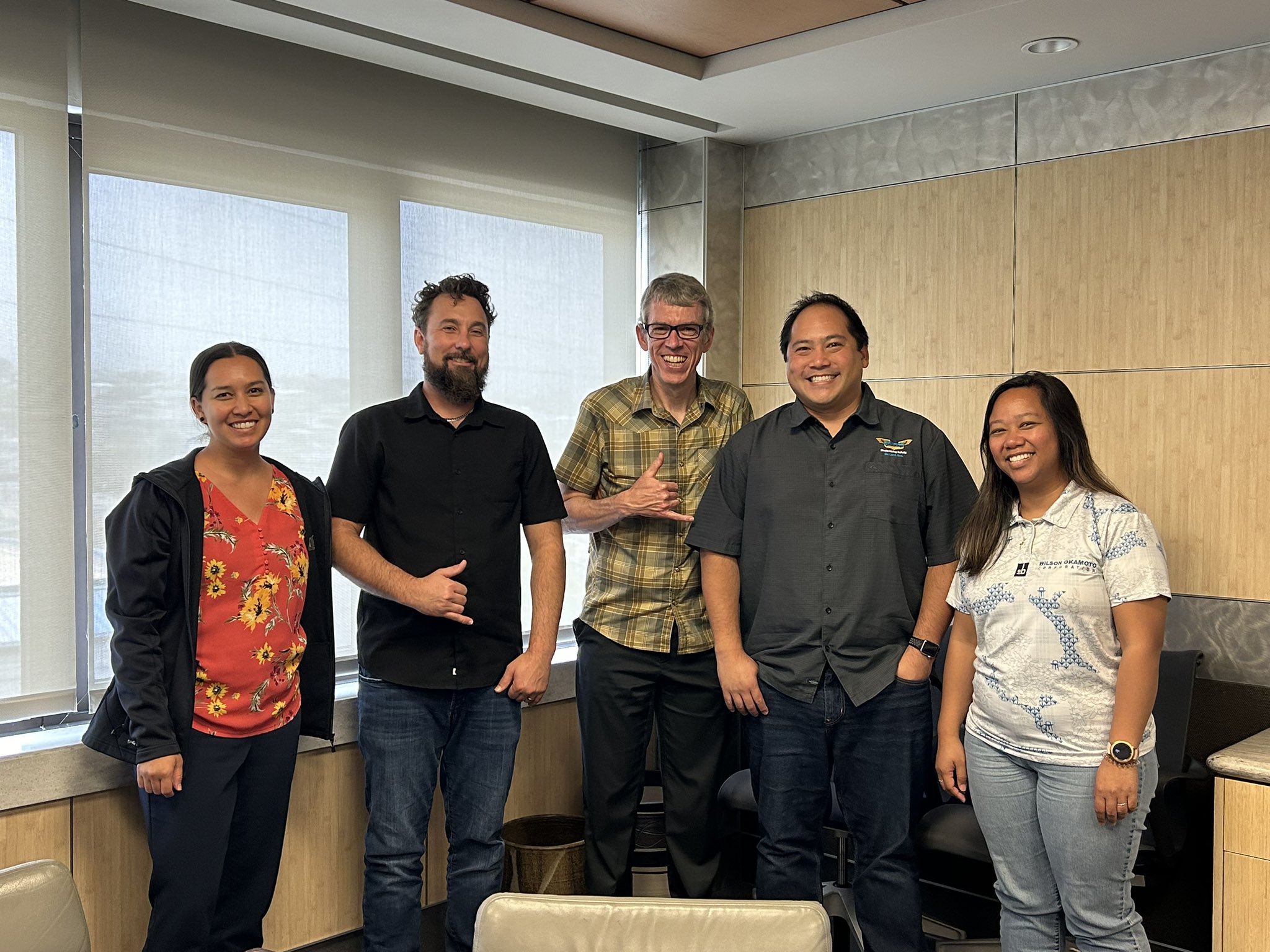October 2019 Meeting Highlights
A section meeting was held on Wednesday, October 30, 2019 at the Frank Fasi Municipal Building. President Jennylyn Tapat welcomed everyone to the meeting and asked everyone to introduce themselves. Following the introductions, Jennylyn asked the committee chairpersons to provide any new updates from the committees. International Director Cathy Leong shared details on the Resume Review Workshop student outreach event that was held at the University of Hawaii (UH) at Manoa. She also reminded everyone that the ITE Hawaii Section with WTS will be hosting a STEM event, The Mitey Rice Challenge, on November 9, 2019 and will include both UH and local high school students. Cathy also provided district and international level updates and announcements including:
- The student chapter at UH may apply for a data collection grant.
- The next joint Western and Mountain District Meeting will be in Honolulu June 28 – July 1, 2020. Abstracts are currently being accepted until December 20, 2019. Cathy reported that over half of the exhibit booths have been sold and the top sponsorships have also been filled.
- The next International ITE Meeting with be joint with the Southern District in New Orleans next August.
Cathy was followed by Legislative Committee Chairperson Wayne Yoshioka with a status update of the recent legislative measures including the postponement of expanding the Restricted Parking Zone Program in Kalihi and Halawa, approval of updating the language of Bill 53 to include mopeds, introduction of a measure to provide free bus passes for school-aged children, and a proposed TIP amendment to allow the City & County of Honolulu to purchase more buses.
After the announcements, Kelly Akasaki went on to introduce the first guest speaker, Melissa May White who is a senior planner with SSFM International in Honolulu, Hawaii. Melissa’s presentation highlighted key takeaways from a panel discussion she facilitated in August 2019 that explored the evolving landscape of micromobility and its integration into cities. Five cities, Portland, OR, San Francisco, CA, Spokane, WA, Minneapolis, MN, and Seattle, WA participated in this panel discussion. Melissa began her presentation with a brief history of micromobility from smart docking stations to dock-less systems, and most recently electronic bikes and scooters. Melissa identified some key strategies and lessons learned in the roll out of micromobility systems in these cities including develop an overall plan, establish policies and regulations, provide dedicated facilities for parking and operations/travel, and have both providers and cities participate in public education and outreach events. Melissa ended with highlighting some of the challenges that micromobility systems face including short lifecycles and transit integration.
After Melisa’s presentation, Kelly introduced the second guest speaker, Dre Kalili who is an executive assistant at the Department of Transportation Services and advises on policy, legislative strategy, and business development. Dre’s presentation focused on Bill 44 which aims to set a framework to manage shared micromobility in Honolulu. Dre outlined the nearly three (3) month long process that involved background research, a survey of 14 cities, drafting the bill, meeting with committees, and hearing public testimony. At the time of the meeting, approval of Bill 44 had been postponed until the next meeting scheduled in November. Dre also highlighted the key goals/outcomes of this bill, which included 1) providing a definition for a shared micromobility vehicle – short-term rental of vehicle l00 pounds or less, 2) charge all shared mobility providers the same amount for use of a city-owned parking stall, 3) add registration requirements for scooters, and 4) ensure the bill is flexible for new devices that may be proposed in the future.
After both presentations, Jennylyn announced that the next meeting will be held in February 2020.
September 2019 Meeting Highlights
A section meeting was held on Wednesday, September 25, 2019 at the Frank Fasi Municipal Building. President Jennylyn Tapat welcomed everyone to the meeting and asked everyone to introduce themselves. Following the introductions, Jennylyn asked the committee chairpersons to provide any new updates from the committees. Student Chapter Liaison Michelle Agustin shared details on two upcoming student outreach events that will be held at the University of Hawaii (UH) at Manoa. First, a Resume Review Workshop will be open to students in the College of Engineering on September 30, 2019. Second, a STEM event, The Mitey Rice Challenge, will be held on November 9, 2019 and is open to both UH and high school students. Michelle was followed by International Director Cathy Leong who provided new updates on the new election rules and procedures for the Western District, which involves two regions: 1) Hawaii, Oregon, Washington, Alaska, and Northern California and 2) Southern California sections. She reminded everyone that the next joint Western and Mountain District Meeting will be in Honolulu June 28 – July 1, 2020 and that abstracts are currently being accepted.
After the announcements, Kelly Akasaki went on to introduce guest speaker Eric Lee Niemeyer, Traffic Operations Engineer for City of Springfield, Oregon. Eric’s presentation highlighted the benefits of installing flashing yellow arrows (FYA) at signalized intersections. Eric began his presentation by summarizing previous research, which found that drivers understand the FYA better than the circular green. However, at that time it was believed that the flashing yellow arrow and static yellow arrow needed to be in separate sections. Thus, the 2009 Manual on Uniform Traffic Control Devices (MUTCD) prohibited the use of three (3) section FYA. Research completed in June 2014 found that there was no difference in driver comprehension between a four (4) section or three (3) section FYA arrangement. In August 2014, FHWA issued Interim Approval (IA-17) that allows three (3) section FYA. Eric went on to share the feedback he received after deploying flashing yellow arrows at signalized intersections. There was a mix of negative and positive comments from the community, but overall the comments were positive. Eric listed the over 30 intersections in Springfield, OR that he converted to FYA. Lastly, Eric identified a potential FYA site on Oahu.
After Eric’s presentation, Jennylyn announced that the next meeting will be held on October 30, 2019 also at the Frank Fasi Municipal Building, 3rd floor.
May 2019 Meeting Highlights
A Section meeting was held on May 21st at the Frank Fasi Municipal Building, 3rd Floor. President Claire Fukuoka welcomed everyone to the meeting and asked everyone to introduce themselves. Following the introductions, Claire asked the committee chairpersons to provide any new updates from the committees. Student Chapter Liaison Eric Imada shared that Abdul Alghamdi will serve as the student chapter president in the upcoming school year and will work with the Section to arrange a professional development workshop for the students. Legislative Committee Chairperson Wayne Yoshioka followed with a summary of the legislative measures that passed this recent session. These measures included the passage of the red light cameras (SB663 SD2 HD1) and changes to the traffic code regarding pedestrian crossings (SB98 HD1 CD1). The former establishes a red light running committee to develop policy recommendations for red light running pilot program and is comprised of state and county administrators while the latter is intended to clarify the requirement that a motorist yield to a pedestrian by specifying when a pedestrian is considered to be within an intersection or adjacent crosswalk. Wayne was followed by International Director Cathy Leong who provided new updates on the on-going OneITE initiative. She reminded everyone that the next District Meeting will be in Monterey, California from June 23-26.
After the announcements, Claire went on to introduce guest speaker Justine Espiritu, Grants and Program Manager from Bikeshare Hawaii. Todd Boulanger was previously scheduled to speak but was unable to attend due to a schedule conflict. Justine’s presentation highlighted the organization’s successes in the last year including an increase in ridership and a 30 percent expansion to the program’s bicycle fleet growing from 100 stations to 130 stations within the last year. Biki was also recently ranked top 6 bikeshare system in the nation by the National Association of City Transportation Officials. Biki users are comprised of a mix of visitors and local residents with residents making up 60-75% of Biki users. As such, Biki has been focused on targeting resident demand including areas like Makiki, Diamond Head, and Iwilei. When asked what initiatives Biki has been involved in to increase infrastructure improvements, Justine shared that Biki has been working closely with the Hawaii Bicycling League to put together workshops to educate riders safe cycling practices and the rules of the road and encourage their members to be involved in town meetings. In the future, the organization plans to explore potential sites for expansion including establishing satellite stations in Kapolei, Haleiwa, and Kailua.
After Justine’s presentation, Claire announced that the next meeting will be the Annual Section meeting and will be held on June 13th also at the Frank Fasi Municipal Building, 3rd floor.
February 2019 Meeting Highlights
President Claire Fukuoka welcomed everyone to the meeting. She then shared some of the legislative bills Legislative Committee Chairperson Wayne Yoshioka has been following. These include measures aimed at increasing pedestrian safety (no right-turn on red) and red light cameras. Wayne has put together a summary of the bills currently under consideration which has been posted on our website. Western District International Director Cathy Leong followed with announcements from the district level and thereafter Vice President Cristina Rodriguez introduced guest speaker Shelly Kunishige, DOT Public Affairs Officer. She was also joined by Marshall Ando, DOT Highways Administrator. The topic of Shelly’s presentation was “Maximizing Hawaii’s Highways: What DOT is doing to implement cost effective congestion relief quickly”. According to Shelly’s presentation, there are currently 2,500 lane miles across Hawaii, of which 25% are considered in good condition, 53% in fair condition, and 22% in poor condition. The organization’s goal is maintain at least 80% of the roadways in either fair or good condition. However, faced with the rising cost of construction and a decrease in highways revenue, DOT has had to reprioritize its projects from improvements aimed to increase roadway capacity to system preservation projects that would utilize the existing right-of-way and provide the greatest benefit for minimal cost. These projects have included the provision of an additional zipper lane, the Nanakuli Contraflow, the Kahekili Highway Resurfacing and Contraflow, and the Keaau-Pahoa Road Restriping between Keaau Town and Shower Drive. The implementation of these projects has helped to increase roadway capacity along the affected areas all the while minimizing significant infrastructure modifications and cost. In addition, DOT is currently designing a project to provide an additional lane to the westbound direction of H-201 between Puuloa and Halawa and in the future, plans to implement additional ITS improvements and upgrade traffic signals along Nimitz Highway to support connected vehicles.




